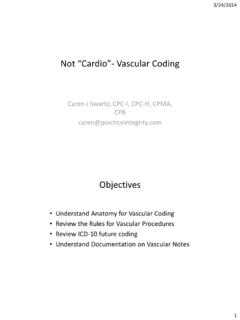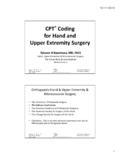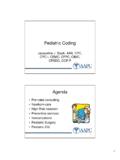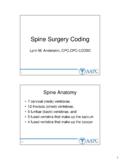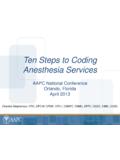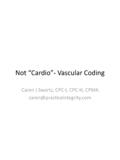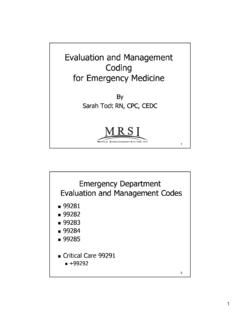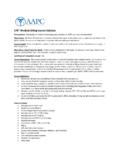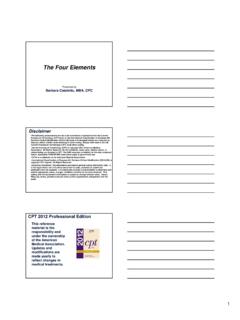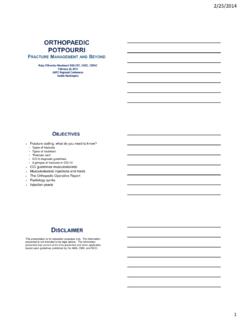Transcription of Cardiovascular And Anesthesia Billing
1 10/10/2012. Cardiovascular And Thoracic Anesthesia Billing AAPC CHICAGO REGIONAL CONFERENCE. Presented by: Judy A. Wilson, CPC, CPC H, CPCO, CPC P, CPPM, CPC I, CANPC. Disclosures All materials in this presentation are based on CPT guidelines and ASA RVG and are true at the time of this presentation. No other disclosures to report 1. 10/10/2012. Covered Topics Cardiac Anesthesia Codes Thoracic Anesthesia Codes Invasive Line Placement TEE Rules for Billing Pacemakers, ICDS. Revascularization Codes Cardiac Anesthesia Operating on a beating heart is off pump and has a 25 base. CABG on or off pump? Stopping, the heart and lungs are on pump and have a 18 20 base. It is a 20 base if in addition to another heart procedure. ( Valve), a re do CABG if more than one (1) month after an original CABG. Remember if a graft is sewn during an off pump procedure, the anesthesiologist is due additional unit due to the increased risk 2.
2 10/10/2012. Cardiac Anesthesia Continued: Off Pump must be documented to get the extra units, which would be an increase of about $ for an average Medicare case. That would be an increase of about $35,000 annually if the group did an average of 420 cases 33517 33523 are listed in the CPT as add on codes and the ASA crosswalk list as NOT A PRIMARY PROCEDURE CODE. Key to Reimbursement is Documentation Qualifying Cardiovascular Circumstances 99100 Anesthesia for patient of extreme age, younger than 1 year and older than 70. 99116 Anesthesia complicated by utilization of total body hypothermia 99135 Anesthesia complicated by utilization of controlled hypotension List all above codes separately in addition to the code for primary Anesthesia procedure. 3. 10/10/2012. Qualifying Cardiovascular Circumstances Continued: Hypothermia is often including in the Anesthesia code and should not be reported separately in those cases.
3 When an anesthesiologist does deliberate hypotensive Anesthesia it is often done as a safe and effective way to reduce blood loss and surgical time as well as reducing the need for blood transfusion during the surgical procedure when the anesthesiologist anticipates excessive blood loss. ( upper thorax or aneurysm). Coding For CABG On/Off Pump; What Code To Use? CABG Coding: 00562, 00566 & 00567. On or Off pump, redo of a prior CABG > than one month Off Pump = 00566 = 25 base units (do not separately bill 99116 or 99135). On Pump = 00567 = 18 base units (do not separately bill 99116 or p 5 7 ( p y 99. 99135) but remember if a valve is also done, use 00562 = 20 base units On Pump redo CABG > 1 month after original = 00562 = 20 base units 4. 10/10/2012. Non CABG; Which Code To Use? On/off pump, age, hypothermic circulatory arrest. Off pump 1 code; 00560 = 15 base units On Pump 3 codes; 00561 = 25 base units < 1 year old; 00562 = 20 base units; > 1 year old or greater; 00563 = 25 base units (with hypothermic circulatory arrest).)
4 Remember do not report or bill separately for codes 99100, 99116, or 99135 with the above procedure. Anesthesia Codes For Thoracic Cases 00528 = 8 base units; Closed chest procedures; mediastinoscopy and diagnostic thoracoscopy not utilizing 1 lung ventilation 00529 = 11 base units; Mediastinoscopy and diagnostic thoracoscopy utilizing 1 lung ventilation. 00540 = 12 base units; thoracotomy procedures involving lungs, pleura, diaphragm, and mediastinum (including surgical thoracoscopy) not otherwise specified. 5. 10/10/2012. Anesthesia Codes For Thoracic Procedures Continued: 00541 = 15 base units; utilizing 1 lung ventilation 00546 = 15 base units; pulmonary resection with thoracoplasty 00548 = 17 base units; intrathoracic procedures on the trachea and bronchi Remember to make sure that one lung ventilation is documented, (an extra 3 base units); not documenting could lead to lost revenue in the thousands over a period of one year.
5 Invasive Lines What must you document to report for Billing ? Placement (because it could have been in situ). Who places it ( because it may have been placed by other than the anesthesiologist). Where placed anatomically (because of coding issues). 6. 10/10/2012. Invasive Lines Continued: There is NO SEPARATE payment for multiple lumen placement You may bill for both the CVP & a Swan Ganz if they are 2 separate lines You must document both line placement and monitoring Remember that CRNAs can insert post op block/invasive line under direction & the anesthesiologists can bill it g If central line and Swan Ganz performed NO PAYMENT FOR CENTRAL LINE THAT IS USED AS INTRODUCER FOR SWAN GANZ. You CAN get paid for central line if: second central line is medically necessary and if second central line is placed in a different anatomical site. Remember you MUST document this! ( 2nd stick). EXAMPLES GIVEN ON NEXT TWO SLIDES.
6 EXAMPLE FOR 2ND LINE. 7. 10/10/2012. EXAMPLE FOR 2ND LINE. TEEs; Are You Getting Paid? Transesophageal Echocardiography (TEE) can be done for monitoring and/or diagnostic purposes TEEs when used to establish conditions such as myocardial ischemia or cardiac valve disorders are diagnostic and can and SHOULD be billed Must append a 59 to show that it is a separate and distinct procedural service. Will also need to append 26 for PC. The anesthesiologist must perform the placement, image acquisition, and interpretation (including a written report) in order to correctly bill for these services. Codes 93312 and 93315 are not bundled into the Anesthesia services. Code 93318 is bundled into the Anesthesia services Tees require special training and certification NOTE: Make sure you use a diagnosis for the TEE and not the one for the surgical procedure 8. 10/10/2012. THOSE HERE JUST FOR THE CEUS.
7 CEU ??? MORE TO COME!!!! 9. 10/10/2012. Cardiac Procedures Using Robotic Assist There is no difference in how you code for Robotic Assisted cases These cases are typically called minimally invasive cardiac surgery and have benefits over the traditional, open chest procedures. Patient time in hospital is shorter, no splitting of the chest, as well as smaller incision just to list a few of the benefits Surgeon uses a thin instrument with miniature cameras, along with a hybrid technique with coronary stenting to perform the operation f Remember you must use a unlisted code 93799 when a coronary sinus catheter following minimally invasive mitral valve surgery. YOU KNOW WHAT THAT MEANS! Complications Causing A Return Trip To The OR. A lot of carriers will deny your take back for complications as both procedure codes are in the same ASA code range. Remember; IT IS A BILLABLE SERVICE as they are two distinct Anesthesia services done on the same patient at diff different times by the same or a different anesthesiologist.
8 T ti b th diff t th i l gi t (Some are on the same date of service and some are not). If denied, make sure you APPEAL and send the Anesthesia records to show two separate services and some carriers will want you to append modifier 59. 10. 10/10/2012. Pacemakers Temporary Pacemaker; They are used to pace the heart when the normal conduction pathway is diseased or damaged. They are placed outside the body; transcutaneous emergency transvenous epicardial Permanent Pacemaker;; They are implanted within the y p body and can stimulate atrium, ventricles or both ICD (implantable cardioverter defibrillator) This device can detect and terminate life threatening episodes of tachycardia or fibrillation Terms To Know Pacemaker: Implantable cardiac device that controls the heart's rhythm and maintains regular beats by artificial electric discharges. This device consists of the pulse generator with a battery and the electrodes, or leads, which are placed in single or dual chambers of the heart, usually transvenously Cardioverter defibrillator: Device that uses both low energy cardioversion or defibrillating shocks and antitachycardia pacing to treat ventricular tachycardia or ventricular fibrillation 11.
9 10/10/2012. Pacemaker Device Insertion > 33212 = Insertion of pacemaker pulse generator only, single chamber, atrial or ventricular with existing single lead > 33213 = Dual chamber with existing dual leads Epicardial placement of the electrode should be reported separately; use 33202/33203 in conjunction with 33212/33213 as appropriate Pacemaker Device Removed/Upgraded Removal = 33233 (removal of permanent pacemaker pulse generator only). Upgrade = 33214 implanted pacemaker system, conversion of single chamber to dual chamber. (includes removal of previously placed pulse generator, testing of existing lead, insertion of new lead, insertion of new pulse generator). NOTE: If epicardial electrode placement is performed , report 33214 in conjunction with 33202 or 33203 as appropriate. 12. 10/10/2012. ICD (Implantable Cardioverter Defibrillator). 93640 = Electrophysiologic evaluation of single or dual chamber pace cardioverter defibrillation threshold evaluation (induction of arrhythmia, evaluation of sensing and pacing of arrhythmia termination) at time of initial implantation or replacement.
10 93641 = with testing on single or dual chamber pacing cardioverter . p g defibrillator pulse generator 93642 = Electrophysiologic evaluation of single or dual chamber . defibrillator (includes defibrillation threshold evaluation of sensing and pacing for arrhythmia termination and programming or reprogramming of sensing or therapeutic parameters). ICD (Implantable Cardioverter Defibrillator CODING TIPS. Codes 93640 & 93641 are reported in addition to the insertion codes at the time of implantation or replacement of the single or dual chamber pacing cardioverter defibrillator electrode leads (93640) or pulse generator (93641). Induction of arrhythmia is included in 93640 & 93641. Do NOT report 93618 separately. Procedure 93640 & 94641 have both a technical and professional component. To report only the professional component, append modifier 26. To report only the technical component, append modifier TC.)
